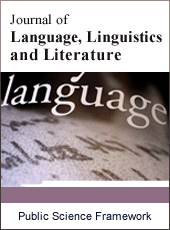Journal of Language, Linguistics and Literature
Articles Information
Journal of Language, Linguistics and Literature, Vol.4, No.1, Mar. 2018, Pub. Date: Mar. 24, 2018
Idiomatic Translation Between English and Arabic: Cultural Differences
Pages: 1-7 Views: 2741 Downloads: 2853
[01]
Hind Al Zahrani, English Language Department, Jubail University College, Jubail, Saudi Arabia.
This paper examines the different levels of difficulties that bilingual translators face when translating idioms in English and Arabic. It aims to suggest some solutions that tackle the amount of difficulty. Since the world is getting smaller, Arabs became more open minded. They like to read, explore, and gain more knowledge about other cultures, therefore, they started investigating and looking for books and articles that are written in foreign languages. These books may include some idioms that need to be translated carefully so it can carry the message correctly. However, the translation of idioms is partially decided by the culture. Thus, improving a cultural awareness, including religious and social, and understanding other cultures are necessary to get the exact meaning of idioms otherwise, translators may find it difficult to deliver the hidden meaning.
Translation, Cultures, Idioms, Equivalence
[01]
Almubarak, A. (2017). The Challenges of Translating Idioms from Arabic into English: A Closer look at Al Imam AL Mahdi University. Flourishing Creativity & Literacy. Volume 5 (1), p. 3. http://www.journals.aiac.org.au/index.php/IJCLTS/article/view/3167/2625
[02]
Anderman, G. & Rogers, M. (1999). Word, text, translation: Liber amicorum for Peter Newmark. (pp. 148). Great Britain: WBC Book Manufacturers Ltd.
[03]
Baker, M. (1992). Inother words. Great Britain: British Library Cataloguing-in-Publication Data.
[04]
Burger, H. (2007). Phraseologie / Phraseology. (pp. 930). German: Walter de Gruyter.
[05]
Fernando, C. (1996). Idioms and idiomaticity: Describing English language. United Kingdom: Oxford University Press.
[06]
Ghazala, H. (2008). Translation as problems and solutions. Riyadh: Kounoz Almarefah.
[07]
Liu, D. (2007). Idioms: Description, Comprehension, Acquisition, and Pedagogy (ESL & Applied Linguistics Professional Series. United Kingdom: Routledge.
[08]
Maestro, G. &Terban, M. (1987). Mad as a wet hen: And other funny idioms. Boston: Houghton Mifflin Harcourt.
[09]
McMordie, J. (1978). English idioms and how to use them. England: Oxford University.
[10]
Moon, R. (1998). Fixed expressions and idioms in English: A corpus-based approach. United Kingdom: Clarendon Press.
[11]
Richards, j. & Schmidt, R. (1983). Language and communication. California: University of Auckland.
[12]
Wulf, S. (2008). Rethinking idiomaticity: A usage-based approach. (Pp. 12-13). London: British Library Cataloguing-in-Publication Data.

ISSN Print: 2381-7054
ISSN Online: 2381-7062
Current Issue:
Vol. 6, Issue 1, March Submit a Manuscript Join Editorial Board Join Reviewer Team
ISSN Online: 2381-7062
Current Issue:
Vol. 6, Issue 1, March Submit a Manuscript Join Editorial Board Join Reviewer Team
| About This Journal |
| All Issues |
| Open Access |
| Indexing |
| Payment Information |
| Author Guidelines |
| Review Process |
| Publication Ethics |
| Editorial Board |
| Peer Reviewers |


